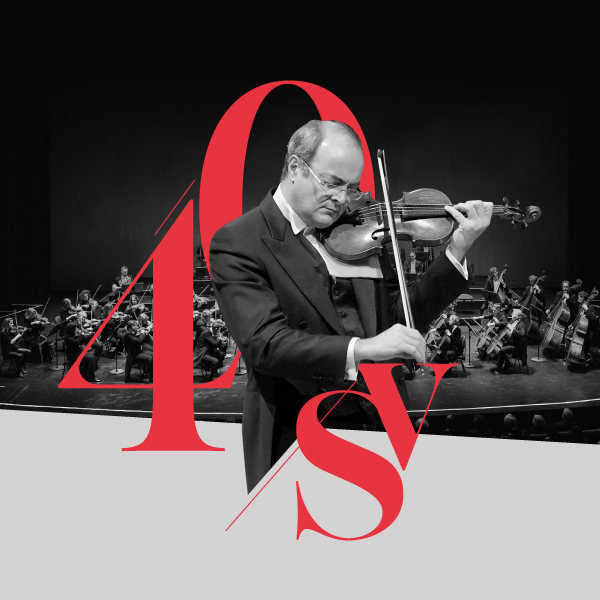

Sinfonia Varsovia
Gordan Nikolić violin, conductor
Johannes Brahms Violin Concerto in D major, Op. 77 [38’]
I. Allegro non troppo
II. Adagio
III. Allegro giocoso, ma non troppo vivace
intermission
Johannes Brahms Serenade No.1 in D-major, Op.11 [49’]
I. Allegro molto
II. Scherzo: Allegro non troppo – Trio. Poco più moto
III. Adagio non troppo
IV. Menuetto I & II
V. Scherzo: Allegro – Trio
VI. Rondo: Allegro
Johannes Brahms took an astonishingly long time to mature to face symphonic music. After the failure of his Piano Concerto No. 1 (1859), which was poorly received by audiences and critics alike, he did not present a new work featuring a large orchestra for almost two decades. Only the enthusiastically received premiere of Symphony No. 1 (1876) lifted the composer up, and he quickly set to work on Symphony No. 2, which was presented to Viennese audiences the following year, and in the following years too he focused mainly on symphonic music, composing the Violin Concerto, two grand overtures, Piano Concerto No. 2 and Symphony No. 3. All of Brahms’s major symphonic works (capped by the Fourth and Double Concerto) were written over a period of eleven years: 1876–1887.
Much earlier, while still working on the First Concerto, Brahms confronted the orchestral material by creating two charming serenades – the first grows out of the chamber spirit, as it was written for a group of musicians of the Detmold princely orchestra, to eventually gain a full orchestral setting (it was successfully presented in Hanover in March 1860). However, it is permeated by the spirit of divertimenti and serenades from the time of the beloved classics. The two scherzos and the double minuet of Serenade in D Major are like delightful “etudes” in these forms, which the author later rarely reached for (the place of the scherzo in his cyclic works is generally taken by nostalgic allegrettos of a dance-like but never jocular character). The expansive first movement in two-theme sonata form is already a preliminary introduction to the symphony, although its bucolic first theme intoned by a horn hints again at a serenade provenanace. The central adagio delights in mood and harmonic invention, foreshadowing the best of Brahms’s mature “bearded” style.
From the aforementioned prolific “symphonic” period also comes Brahms’s singular work for violin and orchestra – the Concerto in D Major, Op. 77. While composing it, he extensively consulted with his friend, the brilliant violinist Joseph Joachim (who was also a talented and popular composer in his era). Separated by a considerable distance, the two musicians sent sketches and comments to each other by mail. Brahms used numerous suggestions for violin texture and articulation, but also introduced many of his own innovative ideas, inspired by his experiences as a piano virtuoso. Hence, many – even eminent – violinists of the era considered the concerto “unplayable” or even “artistically misconceived” (such opinions were formulated by Henryk Wieniawski and Pablo Sarasate, among others). Despite the scale of the difficulty, the work does not belong to the trend of virtuoso, purely showpiece concertos – each element of the complex texture and innovative features of the violinist’s technique remain in the service of artful form and rich expression.
Critics and listeners were also initially appalled by the symphonic premise of the work with a fully self-contained, rich orchestral part. There is a well-known saying (attributed to Hans von Bülow or Josef Hellmesberger) about a “concerto against the violin.” The idea of a “symphony with solo violin” would have been even more fully revealed in the original idea, abandoned for unclear reasons, according to which the piece (like the Piano Concerto No. 2) was to be, contrary to the tradition of the genre, a four-movement work with a scherzo. Interestingly, Brahms did not limit himself to removing the nearly finished scherzo from the score, but also the original slow movement, replacing it with an entirely new adagio. In the end, therefore, the work was presented as a three-movement composition.
The first movement most strongly emphasizes the symphonic conception of the work – full of dynamic and atmospheric contrasts, it combines pastoral and rhapsodic elements in a fascinating way; it is also the most difficult to interpret for the soloist, whose part remains organically melded with the orchestra’s rich texture all the time. The ending features an ad libitum cadenza, entrusted to the soloist’s choice – of course, at the premiere at Leipzig’s Gewandhaus (January 1, 1879), Joseph Joachim played his own, so impressive that at the Vienna premiere the audience applauded it by drowning out the Brahmsian coda (which the composer commented bitingly in one of his letters). In addition to Joachim’s relatively most frequently performed cadenza, more than a dozen others were written by excellent violinists. The Adagio corresponds moodily with the first movement, beginning again with an idyllic motif of a beautiful oboe solo, only to strike later in the dramatic and elegiac tones of the middle episode. The final movement, on the other hand, is a reminiscence of the years of his youth: his collaboration with the Hungarian violinist Reményi and his joint performances with (also Hungarian-born) Joachim of the Hungarian Dances. The extended, brilliant Allegro giocoso rondo, ma non troppo vivace (the note added after the comma limiting the tempo is the realization of Joachim’s suggestion) is in the style of all’ongarese – or rather alla zingarese, as in the 19th century Hungarian music was wrongly identified with popular there, yet distinct, Gypsy music. The concerto’s finale is one of the most joyous and witty, yet most beloved pages of Brahms’s music.
Piotr Maculewicz